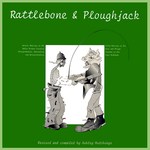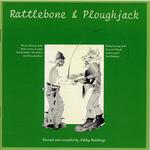> Ashley Hutchings > Records > Rattlebone & Ploughjack
Rattlebone & Ploughjack
 |
Rattlebone & Ploughjack Island HELP 24 (LP, UK, April 1976) |
 |
Devised and compiled by Ashley Hutchings;
Recorded in 1973;
Sleeve designed by Nigel Holmes;
CD reissue with additional liner notes by John Tobler
Personnel
The Personnel is mostly uncredited but includes
John Locke: fiddle;
David Munrow: bagpipes;
Doug Sherriff: melodeon;
John Watcham: concertina;
William Palmer: narration;
Cyril Papworth: dancer;
Albion Morris Men: dancers
Tracks and Sleeve Notes
There is no “official” track list except for the labeling of the two LP sides but careful listening plus Ashley’s original liner notes (reproduced below with additional comments in parentheses) allow disaggregation to the following components (more or less!):
Side 1: Rattlebone
Morris Dancing of the Wales Border Counties Herefordshire, Shropshire and Worcestershire
- Reading from Piers Plowman.
(unnamed reader) - A cylinder recording of the Herefordshire gypsy fiddler John Locke, playing an unnamed hornpipe. Made by Cecil Sharp at the turn of the century.
- Old Hall was the legendary Elizabethan pipe-and-tabor player. This eulogy (unnamed reader) comes from a contemporary pamphlet. The tune for pipe and tabor is Jack off the Green from William Preece of Dilwyn, Hertfortshire.
- The Bromsberrow Heath Three Handed Reel is a tune from
Bromsberrow melodeon player, Beatrice Hill
(unnamed musicians playing melodeon, concertina, tambourine). - This is followed by a local carol (a variant of Christ Made a Trance)
- The Elizabethan actor and morris-dancer William Kemp is said to be the author of the pamphlet Old Meg of Herefordshire for a Mayd Marian and Hereford Towne for a morris daunce or 12 morris dauncers in Herefordshire of 12 hundred years old (1609 London). This quote comes from it.
- The next dance is from Brimfield. The tune is a hornpipe from Stephen Baldwin of Upton Bishop, Herefordshire. (Unnamed dancers plus unnamed musicians playing melodeon, bones, tambourine)
- An account of dancers at Shrewsbury from
Shropshire Notes and Queries, 1885
(unnamed reader) - Dance from Much Wenlock
(unnamed dancers plus unnamed musicians playing Anglo concertina and tambourine) - Broseley Morris tune Om si the Gom.
A stick dance went to this.
(unnamed singer and musician playing vocal and banjo). - One of the earliest references to morris dancers making a nuisance of
themselves. This is from Puritans at a Much Wenlock court case in 1652.
(unnamed reader) - Into Worcestershire. The bagpipes (smallpipes or lowland bagpipe) play two Border tunes, Not for Joe and Sheepskins. The latter is the same tune as Om si the Gom.
- Frozen rivers meant that fishermen couldn’t work, so another way of
raising money was needed.
(unnamed reader) - The future? Albion Morris Men perform the
Upton-Upon-Severn Stick Dance
to electric guitars and drums.
(This track was previously released on The Electric Muse where the musicians were identified as John Watcham, Anglo concertina; Simon Nicol, electric guitar; Ashley Hutchings, bass; Roger Swallow, drums)
Side 2: Ploughjack
Molly Dancing of the Fens and Plough Customs of the East Midlands
- Little Downham, Cambridgeshire, 1931
(unnamed reader) - Birds a’Building dance from Girton, Cambs. When the
leader called “Set!” the dancers bobbed down momentarily
in imitation of birds nesting
(unnamed dancers plus unnamed musician playing Anglo concertina) - The Hi Ninny Naw Nee chant was meant to simulate the sound of
the “nags”.
(unnamed reader and unnamed voices) - Smash the Window dance from Girton
(unnamed dancers plus unnamed musicians playing Anglo concertina and tambourine) - William Palmer reads his own account of a visit to Little Downham on Plough Monday, 1933. As it turned out, this was one of the last times that Molly dancing was to be seen in the Fens.
- Frank Beeton of Balsham, Cambs., had this old rhyme (All in a Row or similar). The Molly dancers used to recite it. (unnamed voices)
- “Cross-Hand” dance from Comberton, Cambs., danced to the tune
Shave the Fiddle
(unnamed dancers plus unnamed musicians playing mouth organ and tambourine) - Into Lincolnshire with the first of many Plough-Play quotes and the sound
of the bagpipes.
(unnamed reader plus unnamed musician playing smallpipes or lowland bagpipe) - Cambridge man Cyril Papworth dances the Broom Dance, which he
first learned from his grandfather, one of the old Comberton Molly
dancers.
(unnamed reader plus unnamed musician playing fiddle) - College Hornpipe dance from Girton, to a tune from the
Little Downham musician George Green.
(unnamed reader plus unnamed dancers plus unnamed musician playing English concertina) - The Straw-Bear quote comes from the
Folk-Lore Society’s journal (volume 20, 1909),
which also contains two wonderful photographs of the Whittlesey
Straw-Bear - the only ones that I know of.
(unnamed reader) - The final tune is from George Green.
(unnamed musicians playing melodeon, banjo and drum) - Little Downham, 1931, again.
(unnamed reader)
Further comments
Other musicians than listed above mostly unidentifiable by this listener (mouth-organ could possibly be Terry Potter of the more-or-less contemporaneous Etchingham Steam Band). Ashley Hutchings appears to take little or no part in the actual performances or readings.
Three Handed Reel and College Hornpipe from this album were transcribed (with some notes and archive photographs) in Ashley Hutchings’ song and tune book A Little Music (Island, 1976).
John Tobler’s 1997 supplementary liner notes mainly deal with Ashley Hutchings’ “curriculum vitae” and other projects, and do not assist in any further elucidation of the album content. A quote from Ashley’s original liner notes:
This album is neither a work of scholarship, nor is it entertainment pure and simple. Rather, it lies somewhere between the two... What I feel is valuable about the Molly and Border Morris is the insight it gives us into the oldest, most basic, least civilised antics of our dancing ancestors... It may well be impossible to satisfactorily capture centuries of tradition on one long-playing record, but what I hope is that I have faithfully related many of the interesting elements that made up these customs and, who knows, possibly even taken you there for a brief moment.
Addendum: since the original release of Rattlebone & Ploughjack in the mid 70s, interest in performing Welsh Border Morris and Fenland Molly Dancing underwent a significant revival as an alternative to the more highly visible Cotswold Morris Tradition. Groups such as The Seven Champions (Molly) and The Shropshire Bedlams / Martha Rhoden’s Tuppeny Dish (Welsh Border) have revived and extended the traditions first brought to public attention on Rattlebone & Ploughjack, including performances of various of the dances thereon. Interesting further information on the Seven Champions and their repertoire is to be found in Lore & Language 6/2 (1987) 65-81 and on Border Morris in general here and here.
Acknowledgements
Many thanks to Tony Rees who provided all of the above.

